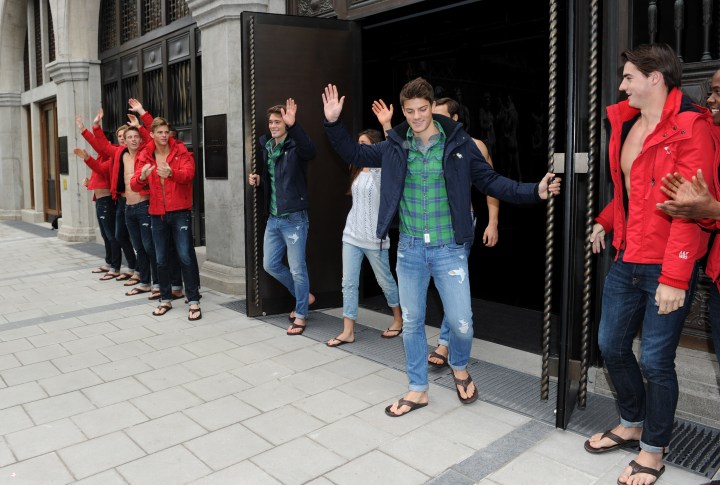
Your uncomfortable stories of trying to dress like you belong
Share Now on:
Your uncomfortable stories of trying to dress like you belong

For a not-small group of millennials, the 2000s Abercrombie & Fitch uniform — artfully ripped denim, logo shirts or rippled abs under sporty jackets, flip-flops for some reason — brings back a stomach-churning sense of dread.
The brand has fallen on hard times, but it once showed teens and tweens the ideal they should aspire to: definitely rich but casual about it, build like a rail or a linebacker, usually white.
In the latest episode of “This Is Uncomfortable,” we heard from listener Wen Wen Yang. She grew up poor in the Bronx, and now she makes more money than either of her parents put together. Like an anthropologist, she finds herself cataloging all the unwritten rules for fitting into the middle class, terrified she’ll out herself by, say, Gorilla Gluing her shoes back together instead of buying new ones.
But Yang isn’t the only one who feels like she doesn’t fit into her own social class. We heard from many of you about the times you felt like an impostor and how you dealt with it. Turns out, a lot of it comes down to clothes. Here are just a few of those stories, lightly edited for clarity and length.
Listener Jen Harris wrote in to tell us that she still remembers the anxiety around name-brand clothing, decades after her school days in Bend, Oregon. It shaped how she shops as an adult.
Junior high was brutal when it comes to wanting brand names. I had
hand-me-downs and when we did buy new clothes, they were on sale and out-of-season. Buy in the summer for fall, and fall or winter in the summer — I learned how to shop on a very tight budget.In eighth grade, there was a girl that wanted nothing more than to be popular, and her way to that was through five outfits all consisting of Guess, Esprit, and Benetton. She worked all summer and bought her five outfits. On the 6th day, when outfit number one was worn again, she was made fun of. I knew right then and there I would never be a label hound.
I still buy summer in the winter and winter in the summer, but my main goal is to purchase key, higher-quality items that won’t go out of style. No one wants to be made fun of on the 6th day.
Over the years, the brands may change but class anxiety stays the same. Kaitlin Montgomery wrote in with this story:
When I was in middle school (2006-ish) I always wanted to look like the popular kids who were wearing Hollister and Abercrombie clothes. My family didn’t have money for any of those clothes, especially the $80 jeans I desperately wanted to be a part of the destroyed and ripped jeans trend. Since I couldn’t buy the jeans I spent an entire Saturday on my driveway with a pair of jeans I already owned, rocks and a pair of scissors to try and make my own distressed jeans. For hours I worked on these pants to try to get them to look like the pants from Hollister but I didn’t have any luck. I ended up giving up and sticking to the pants I already had.
ER doctor Tom Robey told us he is hyper-aware of the message his uniform sends in and out of work:
In few professions do such highly trained and compensated people regularly interact with the most vulnerable, disaffected and down-trodden individuals in our society. Most ER docs wear scrubs, and I don’t wear a white coat because there’s already enough hierarchy built into the system.
Once I leave the hospital, my scrubs elevate into a status marker. So when I drive home, I ditch the clinical garb in favor of ratty jeans or workout clothes. I’d rather not signal that I’m a physician. I guess my scrubs would be a good credential if someone was hurt. But they don’t invite conversations about play dates or home improvement projects.
Finally, listener Lena Delucia from Pennsylvania is adjusting to a new workplace with her old spending habits.
I grew up in a family of frugal spenders. Now, I’m in my late 20s, and I’m working a job where most of my immediate co-workers make between $60 to $100k, but coming from a family where we never flaunted money, I often feel that I don’t really fit in most of my spheres of life. For example, when I see someone with expensive yoga pants and you know I get mine for $10 at Plato’s Closet, or when my co-workers have fancy manicures every week, while I’ve only had two in my entire life … that’s when I feel uncomfortable. I guess I’m still figuring it out.
For more stories about life and how money messes with it, subscribe to “This Is Uncomfortable” wherever you get podcasts. And if you have an uncomfortable money story to share, let us know.
There’s a lot happening in the world. Through it all, Marketplace is here for you.
You rely on Marketplace to break down the world’s events and tell you how it affects you in a fact-based, approachable way. We rely on your financial support to keep making that possible.
Your donation today powers the independent journalism that you rely on. For just $5/month, you can help sustain Marketplace so we can keep reporting on the things that matter to you.











